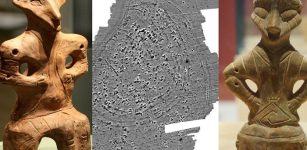Manticore – Legendary Persian Sphinx Whose Existence Is Still Discussed
Ellen Lloyd - AncientPages.com - Whenever the word “sphinx” is mentioned people automatically think about the Great Sphinx of Giza. It’s not surprising because it is today the most famous and admired sphinx of the ancient world. However, we shouldn’t forget there were other, very similar creatures that are today mostly forgotten.
One of them was the Manticore, the legendary sphinx of Persia.
Manticore in an illustration from the Rochester Bestiary (c.1230-1240). Credit: Public Domain
The Manticore was discussed by several ancient Greek authors, and this mysterious being has been depicted in western European Medieval art.
The Persian myth about the Manticore whose name means "man-eater" is very old. The Manticore was a bizarre creature that was said to have the body of a lion, the head of a man, bat wings, and the spiked tail of a scorpion. This combination made the Manticore extremely dangerous and the creature preyed not only on animals but also on humans.
“Originating in Persian mythology (modern Iraq) and documented by Greek naturalists, the manticore is described as having a keen appetite for humans and a howl like that of a trumpet.
The manticore’s morphology no doubt evolved out of necessity from the rugged terrain it occupied in Persia and the Middle East. It needed as many weapons as possible to both hunt a scarce food source and defend itself against predators. Preying on animals such as mountain goats and pigs, the manticore would find itself in human villages lured by the livestock. It is thought that the manticore began to feed on humans, developing a taste for such meat, thus establishing the lore of the man-eating manticore,” William O'Connor explains in Dracopedia The Bestiary.1
“The Manticore should not be confused with the Mantiger (or Mantyger) popular in medieval bestiaries, which had the body of a tiger, the head of a man and the feet of a monkey.”2
When Greek historians became interested in the Manticore, knowledge about this peculiar creature spread across Europe.
Manticore or mantyger badge of William, Lord Hastings, c.1470. Credit: Public Domain
Some, like for example Pausanias (110 – 180), a Greek traveler and geographer who lived during the reign of Roman Emperors Hadrian, Antoninus Pius, and Marcus Aurelius said he had seen many strange creatures in Rome, and among them was the Manticore.
“The beast described by Ctesias in his Indian history, which he says is called martichoras by the Indians and "man-eater" [androphagos] by the Greeks, I am inclined to think is the tiger. But that it has three rows of teeth along each jaw and spikes at the tip of its tail with which it defends itself at close quarters, while it hurls them like an archer's arrows at more distant enemies; all this is, I think, a false story that the Indians passed on from one to another owing to their excessive dread of the beast,” Pausanias wrote in Description of Greece.
Greek philosopher Apollonius of Tyana, (15 AD. - 100 AD.) was also interested in the Manticore and wanted to learn more about this magnificent but unusual animal.
According to Flavius Philostratus (c. 170–247), “Apollonius asked the question, whether there was there an animal called the man-eater (martichoras); and Iarchas replied: "And what have you heard about the make of this animal? For it is probable that there is some account given of its shape."
"There are," replied Apollonius, "tall stories current which I cannot believe; for they say that the creature has four feet, and that his head resembles that of a man, but that in size it is comparable to a lion; while the tail of this animal puts out hairs a cubit long and sharp as thorns, which it shoots like arrows at those who hunt it.” 3
It was through Pliny the Elder’s book Naturalis Historia the Manticore became famous in Medieval Europe. Descriptions and depictions of the Manticore varied and there was plenty of confusion about the nature and origin of this strange animal. In Inferno, part one of Dante Alighieri’s Divine Comedy, the mythical creature Geryon was depicted as a Manticore.
Woodcut from Edward Topsell's The Historie of Four-Footed Beasts (1607)
Today there is still a dispute about the existence of the Manticore. Some think it’s an extinct species, while others suggest the animal is an unknown type of tiger. One possibility is also that the Manticore could have been some sort of a Chimera, a monstrous Greek creature that was composed of several different animals.
Whatever the truth may be, the fact remains that the Manticore can still be encountered in more modern literature. For example, readers of George R.R. Martin's A Song of Ice and Fire books will remember how the author mentioned that Manticore venom is a very toxic poison.
Written by Ellen Lloyd – AncientPages.com
Copyright © AncientPages.com All rights reserved. This material may not be published, broadcast, rewritten or redistributed in whole or part without the express written permission of AncientPages.com
Expand for references- William O'Connor - Dracopedia The Bestiary: An Artist's Guide to Creating Mythical Creatures
- Jack Goldstein - 101 Amazing Mythical Beasts
- Flavius Philostratus, The Life of Apollonius of Tyana, translated by F. C. Conybeare, volume I, book III. Chapter XLV, pp. 327–329.
More From Ancient Pages
-
 Homo Erectus Was Too Lazy And Went Extinct
Archaeology | Aug 14, 2018
Homo Erectus Was Too Lazy And Went Extinct
Archaeology | Aug 14, 2018 -
 Did The 8 Omens Of The Aztecs Foretell The End Of Their Civilization?
Civilizations | Jan 30, 2020
Did The 8 Omens Of The Aztecs Foretell The End Of Their Civilization?
Civilizations | Jan 30, 2020 -
 Final Journey Of Ötzi Iceman: More Clues Found In Frozen Moss
Archaeology | Nov 1, 2019
Final Journey Of Ötzi Iceman: More Clues Found In Frozen Moss
Archaeology | Nov 1, 2019 -
 New Evidence Reveals That Humans Settled In Americas At Least 13,000 Years Ago
Archaeology | Sep 4, 2017
New Evidence Reveals That Humans Settled In Americas At Least 13,000 Years Ago
Archaeology | Sep 4, 2017 -
 Five Ancient Roman Tombs With Different Architectural Style Discovered In Egypt
Archaeology | Aug 26, 2017
Five Ancient Roman Tombs With Different Architectural Style Discovered In Egypt
Archaeology | Aug 26, 2017 -
 Mystery Of The Giant Hand At The Temple Of Hercules
Featured Stories | Jul 17, 2019
Mystery Of The Giant Hand At The Temple Of Hercules
Featured Stories | Jul 17, 2019 -
 Paracelsus: Physician, Alchemist, Philosopher Well Ahead Of His Time
Featured Stories | Apr 28, 2016
Paracelsus: Physician, Alchemist, Philosopher Well Ahead Of His Time
Featured Stories | Apr 28, 2016 -
 Very Rare Ancient Roman Horse Brooch Discovered In UK
Archaeology | Mar 7, 2020
Very Rare Ancient Roman Horse Brooch Discovered In UK
Archaeology | Mar 7, 2020 -
 Fragment Of Unique Ancient Greek Terracotta Statue Uncovered In Underwater Diggings
Archaeology | Mar 26, 2017
Fragment Of Unique Ancient Greek Terracotta Statue Uncovered In Underwater Diggings
Archaeology | Mar 26, 2017 -
 Hidden Details In Ancient Egyptian Tomb Paintings Revealed By Chemical Imaging
Featured Stories | Jul 28, 2023
Hidden Details In Ancient Egyptian Tomb Paintings Revealed By Chemical Imaging
Featured Stories | Jul 28, 2023 -
 What Rights Did Viking Women Have?
Ancient History Facts | Mar 19, 2021
What Rights Did Viking Women Have?
Ancient History Facts | Mar 19, 2021 -
 Faces Of Queen Nefertiti And King Akhenaten Reconstructed Using Artificial Intelligence
News | Mar 22, 2021
Faces Of Queen Nefertiti And King Akhenaten Reconstructed Using Artificial Intelligence
News | Mar 22, 2021 -
 Ancient Egyptian Papyrus Tells A Different Story About Biblical Isaac’s Fate
Archaeology | May 1, 2018
Ancient Egyptian Papyrus Tells A Different Story About Biblical Isaac’s Fate
Archaeology | May 1, 2018 -
 Huge Unknown 7,000-Year-Old Vinca Settlement Found In Serbia?
Archaeology | Apr 30, 2024
Huge Unknown 7,000-Year-Old Vinca Settlement Found In Serbia?
Archaeology | Apr 30, 2024 -
 Story Behind The Two Keys On Vatican’s Flag
Ancient History Facts | Feb 28, 2018
Story Behind The Two Keys On Vatican’s Flag
Ancient History Facts | Feb 28, 2018 -
 2,500-Year-Old Phoenician Shipwreck Being Rescued By Archaeologists
Archaeology | Jul 4, 2023
2,500-Year-Old Phoenician Shipwreck Being Rescued By Archaeologists
Archaeology | Jul 4, 2023 -
 Never-Before-Seen Ancient Texts Hidden In Saint Catherine’s Monastery In Sinai Are Now Available Online
Archaeology | Dec 21, 2017
Never-Before-Seen Ancient Texts Hidden In Saint Catherine’s Monastery In Sinai Are Now Available Online
Archaeology | Dec 21, 2017 -
 Surprising DNA Study Links Present-Day Native American Tribe To Ancestors In San Francisco Bay Area
Archaeology | Mar 22, 2022
Surprising DNA Study Links Present-Day Native American Tribe To Ancestors In San Francisco Bay Area
Archaeology | Mar 22, 2022 -
 London Was Always A Multicultural City, DNA Research Confirms
Archaeology | Nov 26, 2015
London Was Always A Multicultural City, DNA Research Confirms
Archaeology | Nov 26, 2015 -
 Evidence Of Cosmic Catastrophe 12,800 Years Ago – Earth Collided With Fragments Of A Comet
Archaeology | Feb 2, 2018
Evidence Of Cosmic Catastrophe 12,800 Years Ago – Earth Collided With Fragments Of A Comet
Archaeology | Feb 2, 2018



